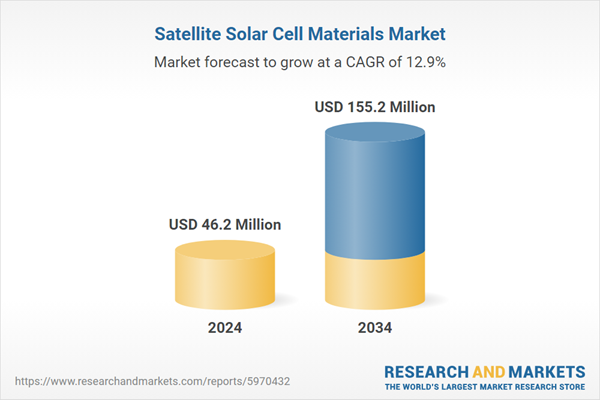10% Free customization
The global satellite solar cell materials market is witnessing a notable upswing, propelled by diverse factors and market trends. Considering the optimistic scenario, the market is valued at $46.2 million in 2024 and is expected to grow at a CAGR of 12.88% to reach $155.2 million by 2034. This growth trajectory is largely driven by the surging demand for high-efficiency solar cells in the satellite industry, which is essential for powering satellites in both communication and earth observation sectors. The critical role of satellite solar cell materials in ensuring the long-term operation and reliability of satellites in harsh space environments is a key factor in this market expansion. This report comes with 10% free customization, enabling you to add data that meets your specific business needs.
Material science innovations and technological advancements in solar cell technology are crucial growth drivers. Developments in high-efficiency photovoltaic materials, such as multi-junction solar cells, offer enhanced performance in power generation, essential for meeting the energy demands of increasingly complex satellite missions. The incorporation of advanced materials such as gallium arsenide (GaAs) and indium phosphide (InP) pushes the efficiency boundaries further, catering to the need for sustainable and reliable energy sources in space.
Regulatory frameworks and sustainability goals also shape this market's landscape, with increased emphasis on minimizing space debris and extending satellite lifespans. These guidelines promote the adoption of more efficient and durable solar cell materials, aligning with efforts to ensure the sustainable use of outer space.
Digital advancements across the aerospace sector, combined with strategic investments in space technology, underscore the market's potential for significant growth. As the industry seeks to enhance satellite capabilities and operational efficiencies through technological innovation, the demand for advanced satellite solar cell materials is poised for sustained growth, fueled by the imperative for more effective and sustainable space-based solutions.
Market Segmentation:
Segmentation 1: by Application
- Communication Satellites
- Earth Observation Satellites
- Navigation Satellites
- Military and Defense Satellites
- Weather Satellites
- Others
Segmentation 2: by Solar Cell Type
- Single-Junction Solar Cells
- Multi-Junction Solar Cells
- Others
Segmentation 3: by Material Type
- Silicon
- Gallium Arsenide (GaAs)
- Indium Phosphide (InP)
- Others
Segmentation 4: by Orbit
- Low Earth Orbit (LEO)
- Medium Earth Orbit (MEO)
- Sun-Synchronous Orbit (SSO)
- Geostationary Orbit (GEO)
- Highly Elliptical Orbit (HEO)
Segmentation 5: by Region
- North America
- Europe
- Asia-Pacific
- Rest-of-the-World
Key Market Players and Competition Synopsis
The companies that are profiled in the global satellite solar cell materials market have been selected based on input gathered from primary experts and analyzing company coverage, product portfolio, and market penetration.Some of the prominent companies in this market are:
- SHARP CORPORATION
- Spectrolab
- Mitsubishi Electric Corporation
- NORTHROP GRUMMAN
- Azure Space Solar Power GmbH
- Thales Alenia Space
- Rocket LAB USA
- CESI S.P.A
- Airbus
Key Questions Answered in this Report:
- What are the main factors driving the demand for satellite solar cell materials market?
- What are the major patents filed by the companies active in the global satellite solar cell materials market?
- Who are the key players in the global satellite solar cell materials market, and what are their respective market shares?
- What partnerships or collaborations are prominent among stakeholders in the global satellite solar cell materials market?
- What are the strategies adopted by the key companies to gain a competitive edge in satellite solar cell materials industry?
- What is the futuristic outlook for the satellite solar cell materials market in terms of growth potential?
- What is the current estimation of the global satellite solar cell materials market, and what growth trajectory is projected from 2024 to 2034?
- Which application, and product segment is expected to lead the market over the forecast period (2024-2034)?
- What could be the impact of growing end-use industries in the global satellite solar cell materials market?
- Which regions demonstrate the highest adoption rates for global satellite solar cell materials market, and what factors contribute to their leadership?
This product will be delivered within 3-5 business days.
Table of Contents
Executive SummaryScope and DefinitionMarket/Product DefinitionKey Questions AnsweredAnalysis and Forecast Note6. Research Methodology
1. Markets: Industry Outlook
2. Global Satellite Solar Cell Materials Market by Application
3. Global Satellite Solar Cell Materials Market by Products
4. Global Satellite Solar Cell Materials Market by Region
5. Companies Profiled
Companies Mentioned
- SHARP CORPORATION
- Spectrolab
- Mitsubishi Electric Corporation
- NORTHROP GRUMMAN
- Azure Space Solar Power GmbH
- Thales Alenia Space
- Rocket LAB USA
- CESI S.P.A
- Airbus
- Microlink Devices, Inc.
- Kyocera Corporation
- Bosch Solar Energy
- SolAero Technologies Corp.
- Lockheed Martin Space Systems
- SpaceTech
Table Information
| Report Attribute | Details |
|---|---|
| No. of Pages | 100 |
| Published | May 2024 |
| Forecast Period | 2024 - 2034 |
| Estimated Market Value ( USD | $ 46.2 Million |
| Forecasted Market Value ( USD | $ 155.2 Million |
| Compound Annual Growth Rate | 12.8% |
| Regions Covered | Global |
| No. of Companies Mentioned | 15 |









